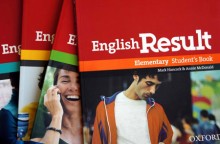English Result - overview

English Result was first conceived in 2002, five years before the first book in the series saw the light of day, and nearly a decade before the series was complete. We set to work at the suggestion from OUP, and decided to write the adult coursebook that we ourselves would want to use. It would combine all of the appeal of intrinsically motivating lessons with the objective standards and wisdom of the Common European Framework of Reference (CEFR).
At the time of writing, we were able to cross-reference our language and skills syllabus, and design appropriate assessment criteria, thus giving each level internal coherence within the CEFR. Each level provides materials to help learners progress from one level to another for all 5 skills throughout the course, that is, reading, writing, listening, spoken interaction and spoken production.
As regards intrinsic appeal, we reflected on our years of classroom experience and listed all of the types of lesson focus which always seemed to work well. We classified these into four broad categories represented in the acronym IPEC - interest, personalisation, entertainment and challenge. We tried to ensure that each lesson would have one of the IPEC qualities at its core, to act as an "attention magnet" to draw the students in.
We located these attention magnets on the left-hand, "impact" page of each spread, unspoilt by didactic explanations or rubrics. This impact page was intended to appeal to the student-as-person - the kind of content that they'd want to look at even if they weren't studying the language. The right-hand, "lesson" page, meanwhile, was designed to appeal to the student-as-learner. It shows the whole lesson as a path of learning activities from How to in the top left to Can do in the bottom right.
The right-hand, "lesson" page, meanwhile, was designed to appeal to the student-as-learner. It shows the whole lesson as a path of learning activities from How to in the top left to Can do in the bottom right.
- Clear focus on motivation
- Two-page lesson format - input material on the left, activities on the right.
- Practical 'How to' lessons with 'I can' goals
- DVDs for students and teachers
- Resources for interactive whiteboards - English Result iToolsTeacher Resource Packs include DVDs and photocopiable activities for every unit
- New Student's Book and DVD Packs include a DVD of culture-rich material
These features are introduced in the video below









Add new comment